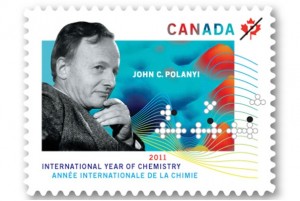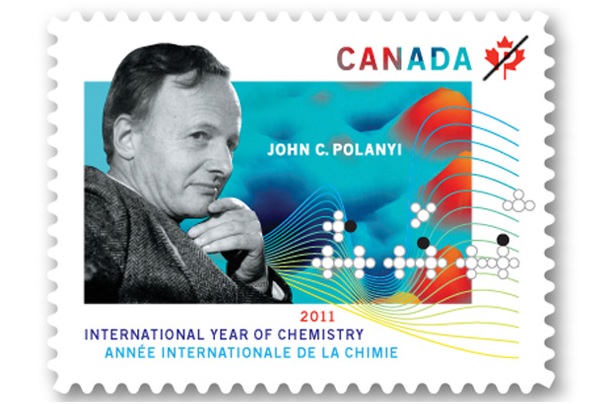by Tyler Irving
Chemistry subject editor
The Nobel Prizes are a bonanza for science communicators, as they give us a rare opportunity to talk about topics that would not otherwise come up in conversation. Canadians recently got a taste of this when Arthur B. Macdonald shared the 2015 Nobel Prize in Physics, and the media was suddenly – and rightly – interested in neutrinos. Today, in my last column for Science Borealis, I’m going to shamelessly piggyback on this wave of interest to do something I’ve wanted to do for a long time: explain the science behind another Canadian Nobel Prize, this one in Chemistry.

Along with recent Nobel Prize winner Arthur B. Macdonald, John Polanyi is one of two Nobel laureates in scientific disciplines still living and working in Canada.
In 1986, John Polanyi shared the Nobel Prize in Chemistry with Dudley R. Herschbach of Harvard University and Yuan T. Lee at the University of California, Berkeley. Though many other Canadians have won Nobels before and since, Polanyi and Macdonald are the only two Nobel laureates in scientific disciplines still living and working in Canada.
Polanyi, a professor of chemistry at the University of Toronto, has been honoured in many ways over the years: among other things, he is a Companion of the Order of Canada, has a school named after him in Toronto, and was featured on a commemorative stamp marking the International Year of Chemistry in 2011.
Yet, as a skeptical editor once pointed out to me, few Canadians could tell you what exactly Polanyi’s discovery was, and why it was so important to chemistry. I took this as an implicit challenge, and vowed that one day I would attempt to explain Polanyi’s work in simple, accessible language.
So here goes: Polanyi and his co-winners advanced chemistry using the same trick that made made Ghostbusters famous – they crossed the streams.
Molecules are far too small to be seen in a microscope. Most of what we know about chemical reactions comes from studying substances in the form of powders or solutions, which even in tiny amounts contain billions and billions of particles. In other words, measuring their properties doesn’t tell us much about individual molecules. And even when sophisticated modern techniques – often involving lasers – do allow us to measure things at the level of single molecules, what we usually get is a picture of what they looked like before or after a given chemical reaction; what happens in between is a bit of a black box.
This was even more the case in the 1950s, when Polanyi’s co-winners Hershbach and Lee began their work on a new experimental apparatus. At its core, it was basically an oven that heated substances, causing their molecules to evaporate into the gas phase. The hot molecules then sprayed out of a hole in the oven toward a low-pressure chamber. However, before they got there, the molecules had to pass through a carefully designed series of filters, including some made of slotted discs that rotated at a specific and controlled speed.
Hershbach and Lee designed the system so that only molecules travelling at a specific speed and direction would get through this gauntlet of barriers. This meant that the final stream of molecules was well characterized; that is, the scientists had a very good idea of how fast and in what way the individual molecules were moving, even if they couldn’t see them directly.
Now for the clever bit: the scientists set up two of these streams, each composed of a single type of molecule. At the point where they crossed, the two different molecules would collide. For a split second, they would become something wonderful, almost magical: a smushed-together hybrid of two molecules that was neither one thing nor the other, but rather a transitional state between the two. It was a kind of chimera, and it was exactly the thing that had eluded earlier chemists.
For his part, Polanyi recognized that in this strange transitional state, some of the electrons in the hybrid molecule got excited and jumped to higher energy levels. After the reaction was over, the electrons in the product molecules would relax and give off their excess energy in the form of a very faint amount of infrared light. By analysing this light, Polanyi and his team could get specific information about what the hybrid had looked like. In effect, for the first time, they could see into the heart of a reaction.
“So what?” you may ask. Why is it important to study the dynamics of a chemical reaction in progress? After all, chemistry is about making new things by combining molecules. As long as we know what we’re starting and ending with, who cares what happens in the middle?
I have two responses. First, nature is capable of some incredible reactions that we would dearly love to understand. For example, the way in which plants and other photosynthesizers use molecules like chlorophyll to turn water, CO2 and light into stored chemical energy is still not completely understood. What if we could understand it, or what if we could build our own molecules that catalyze the reaction just as well, or even better? What could that mean for the way we power our societies? Those who follow in Polanyi’s footsteps are hard at work on these problems.
But more importantly, studying the dynamics of chemical reactions allows us insight into the way our universe works, and that is worth doing in and of itself. The value of so-called “blue sky” or basic research – as opposed to applied research, conducted with a particular goal in mind – is something Polanyi himself has been very articulate about. I’ll leave the last word to him, from an interview he gave me about five years ago:
“It’s an awkward but fundamental truth, that scientific discoveries worth having are always a surprise. The more important the scientific discovery, the greater the amount of surprise. This is a very awkward fact for government science: how do you make a proposal saying ‘In a year or two, I’m going to be surprised.’ But it’s what you have to do.”




